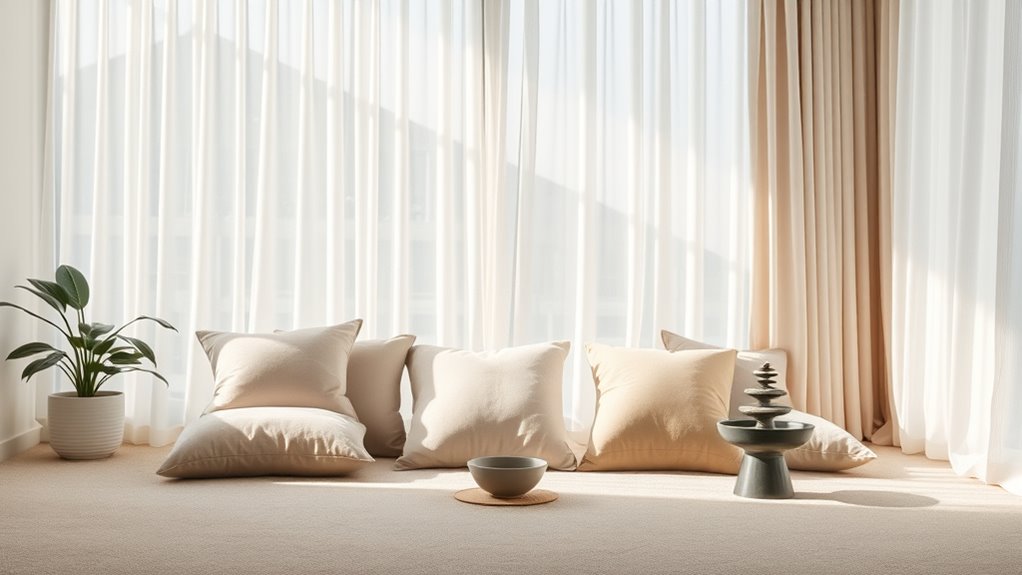To reduce noise and sensory overload, create a calming environment using noise-canceling headphones or earplugs, and incorporate soft lighting, natural textures, and soothing visuals like beaches or forests. Limit exposure to loud environments and digital screens, and set boundaries around noise sources. Practice mindful breathing and incorporate quiet activities to reset your mental state. To discover more ways to manage overload effectively, keep exploring these strategies and tips.
Key Takeaways
- Use noise-canceling headphones or earplugs to block out excess sounds and create a quieter environment.
- Incorporate calming visuals like nature scenes or soft lighting to reduce sensory overload.
- Practice mindful breathing techniques to lower stress and maintain mental clarity amidst noise.
- Design spaces with natural textures, gentle colors, and soft lighting to promote tranquility at home or work.
- Limit exposure to loud environments and digital screens, scheduling regular breaks for relaxation and sensory reset.

In today’s busy world, noise and sensory overload can easily become overwhelming, affecting your focus, mood, and overall well-being. When you’re bombarded with constant sounds—from traffic and chatter to the ringing of notifications—it’s easy to feel stressed or anxious. To counteract this, practicing mindful breathing can be a powerful tool. By intentionally slowing your breath and focusing on each inhale and exhale, you create a moment of calm amidst chaos. This simple act helps ground you, reducing the physiological effects of stress and clearing your mind. Pairing mindful breathing with calming visuals can amplify this effect. Find a quiet space or even close your eyes and imagine a serene scene—like a peaceful forest, a calm beach, or a gentle stream. These visuals engage your mind differently, helping to diminish sensory overload and restore your mental balance. Additionally, incorporating color accuracy into your calming visuals can deepen relaxation by creating more immersive and realistic scenes. Creating a sensory-friendly environment is another effective strategy. Use noise-canceling headphones or earplugs to block out excessive sounds, especially in noisy settings. When you’re at home or in a calming space, consider incorporating elements that promote tranquility—soft lighting, gentle colors, and natural textures. These calming visuals can help your brain shift focus away from overwhelming stimuli and towards a sense of peace. Setting boundaries around your exposure to loud environments and digital screens also plays a vital role. Limit your time on devices, especially if notifications and bright screens contribute to sensory overload, and make space for quiet activities like reading or listening to soft music. Designing your daily routine to include regular breaks is equally important. Step away from your work or screens periodically to take deep breaths and glance at calming visuals—perhaps a plant, a picture of nature, or a calming artwork. These small pauses can prevent sensory overload from building up and help you reset. Remember, reducing noise and sensory overload isn’t about avoiding stimuli entirely; it’s about managing your environment and responses effectively. Mindful breathing and visual relaxation techniques are simple yet powerful tools that you can use anytime, anywhere. They allow you to reclaim control over your mental state, helping you stay centered and resilient despite external chaos. With consistent practice, you’ll find it easier to navigate noisy environments and maintain a sense of calm, no matter what life throws your way.
Frequently Asked Questions
How Can I Identify My Personal Sensory Triggers Effectively?
To identify your personal sensory triggers, start with sensory detection by paying close attention to how different environments make you feel. Practice trigger awareness by noting when you experience discomfort or overwhelm. Keep a journal to track specific situations, sounds, sights, or scents that cause reactions. Over time, you’ll recognize patterns and pinpoint your triggers, allowing you to better manage or avoid them.
Are There Specific Apps or Tools to Help Manage Sensory Overload?
Managing sensory overload is like having a personal compass. You can use assistive technology apps like Sensory Processing Tracker or MySensory to help monitor your sensory input and identify triggers. These tools act as your sensory map, offering insights through sensory tracking features. They help you recognize patterns, manage overwhelm, and adapt your environment, making daily life easier and more manageable. Give them a try to regain control over your sensory experiences.
What Dietary Changes Can Reduce Sensory Sensitivity?
To reduce sensory sensitivity, you should focus on an anti-inflammatory diet filled with sensory-friendly foods like fresh fruits, vegetables, and omega-3 rich fish. Avoid processed foods, artificial additives, and sugar, as they can heighten sensory responses. Incorporate gentle, whole foods that support brain health and reduce inflammation, helping to calm your senses. Consistently choosing these foods can make a noticeable difference in your sensory comfort and overall well-being.
How Does Sleep Quality Influence Sensory Overload Levels?
Ironically, good sleep quality can be your secret weapon against sensory overload. When you prioritize sleep hygiene, your brain’s sensory regulation improves, making you less overwhelmed by stimuli. Adequate rest helps stabilize your nervous system, reducing sensitivity to noise, lights, and textures. So, by simply improving your sleep habits, you give your brain a reset, ensuring you’re better equipped to handle sensory challenges with calm and clarity.
Can Mindfulness Techniques Help in Reducing Sensory Overload?
Yes, mindfulness meditation can help reduce sensory overload. By practicing mindfulness, you enhance your sensory awareness, allowing you to recognize overstimulating stimuli without reacting immediately. This practice helps you stay present and calm, making it easier to manage sensory input. Regular mindfulness meditation trains your mind to stay centered, which can markedly decrease feelings of overload and improve your overall sensory regulation.
Conclusion
By reducing noise and sensory overload, you create a calmer, more focused environment. It’s often believed that a quieter space boosts clarity and well-being, and research supports this idea. When you minimize distractions, you give your mind room to breathe and process effectively. So, consider this: simplifying your surroundings isn’t just about comfort—it’s about uncovering your full potential. Embrace the quiet, and you might find clarity and peace you never knew were possible.









